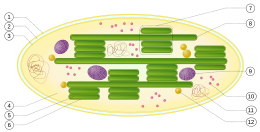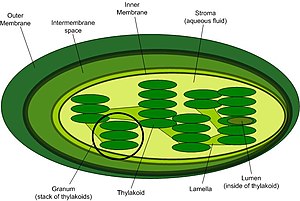

1. outer membrane
2. intermembrane space
3. inner membrane (1+2+3: envelope)
4. stroma (fluid)
5. thylakoid lumen (inside of thylakoid)
6. thylakoid membrane
7. grana (stacks of thylakoids)
8. thylakoid (lamella)
9. starch
10. ribosome
11. plastidial DNA
12. plastoglobule (drop of lipids)

Chloroplasts are small organelles inside the cells of plants and algae. They absorb light to make sugar in a process called photosynthesis. The sugar can be stored in the form of starch. Chloroplasts contain the molecule chlorophyll, which absorbs sunlight for photosynthesis. In addition to chlorophyll, a chloroplast uses carbon dioxide (CO2) and water (H2O) to form sugar and gives off oxygen (O2). Chlorophyll is what gives green plants their green colour. Chloroplasts also contain various yellow and orange pigments to assist in photon capture for photosynthesis.
Structure
Each chloroplast is surrounded by a double walled semi-permeable membrane. In the layered stacks are flat disk-shaped thylakoids. They contain light-absorbing pigments, including chlorophyll and carotenoids, as well as proteins which bind the pigments. Like mitochondria, chloroplasts also contain their own DNA and ribosomes.
Evolution
Chloroplasts are one of the many different types of organelles in the cell. They are thought to have originated as endosymbiotic cyanobacteria. This was first suggested by Mereschkowsky in 1905[1] after an observation by Schimper in 1883 that chloroplasts closely resembled cyanobacteria.[2] Almost all chloroplasts are thought to derive directly or indirectly from a single endosymbiotic event.[3]
Mitochondria also had a similar origin, but chloroplasts are found only in plants and protista. In green plants, chloroplasts are surrounded by two lipid-bilayer membranes. They are thought to correspond to the outer and inner membranes of the ancestral cyanobacterium.[4] Chloroplasts have their own genome, which is much smaller than that of free-living cyanobacteria. The DNA which remains shows clear similarities with the cyanobacterial genome. Plastids may contain 60–100 genes whereas cyanobacteria often contain more than 1500 genes.[5] Many of the missing genes are encoded in the nuclear genome of the host.
In some algae (such as the heterokonts),[6] chloroplasts seem to have evolved through a secondary event of endosymbiosis, in which a eukaryotic cell engulfed a second eukaryotic cell containing chloroplasts, forming chloroplasts with three or four membrane layers. In some cases, such secondary endosymbionts may have themselves been engulfed by still other eukaryotes, thus forming tertiary endosymbionts. In the alga Chlorella, there is only one chloroplast, which is bell-shaped.
In some groups of mixotrophic protists such as the dinoflagellates, chloroplasts are separated from a captured alga or diatom and used temporarily. These klepto (stolen) chloroplasts may only have a lifetime of a few days and are then replaced.[7]
References
- ↑ Mereschkowsky C (1905). "Über Natur und Ursprung der Chromatophoren im Pflanzenreiche". Biol Centralbl. 25: 593–604.
- ↑ Schimper AFW (1883). "Über die Entwicklung der Chlorophyllkörner und Farbkörper". Bot. Zeitung. 41: 105–14, 121–31, 137–46, 153–62.
- ↑ An exception is Paulinella chromatophora, which has recently acquired a photosynthetic cyanobacterial endosymbiont which is not closely related to chloroplasts of other eukaryotes: "Diversity and evolutionary history of plastids and their hosts". American Journal of Botany. 91: 1481–1493. 2004. doi:10.3732/ajb.91.10.1481.
((cite journal)): Unknown parameter|hi=ignored (help) - ↑ Joyard J Block MA, Douce R (1991). "Molecular aspects of plastid envelope biochemistry". Eur J Biochem. 199 (3): 489–509. doi:10.1111/j.1432-1033.1991.tb16148.x. PMID 1868841.
- ↑ Martin W. Rujan T. Richly E. (2002). "Evolutionary analysis of Arabidopsis, cyanobacterial, and chloroplast genomes reveals plastid phylogeny and thousands of cyanobacterial genes in the nucleus". Proc. Natl. Acad. Sci. U.S.A. 99 (19): 12246–51. doi:10.1073/pnas.182432999. PMC 129430. PMID 12218172.
((cite journal)): Cite has empty unknown parameter:|month=(help) - ↑ A large group of non-green algae and some fungus-like types. They are unified by the possession of two unequal flagella at a stage in their life-cycle. They include brown, golden, yellow-green algae and diatoms.
- ↑ Skovgaard A (1998). "Role of chloroplast retention in a marine dinoflagellate" (PDF). Aquatic Microbial Ecology. 15: 293–301. doi:10.3354/ame015293.